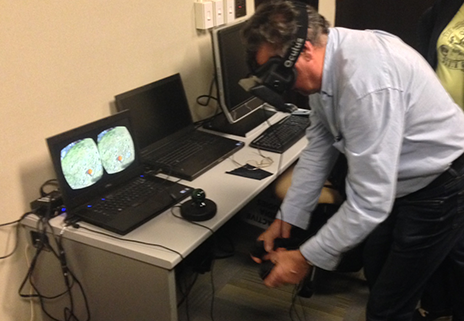How my father-in-law went from Oxford to Tuscany and back thanks to the Oculus Rift

Research into the use of digital games for the benefits of older adults seems to be on the rise in academic literature. At least, it has been remarkable how much more articles on the matter Google Scholar is pushing to me the last couple of months. Unfortunately, the bulk of research out there still seems to focus on the potential beneficial side effects of playing digital games, while neglecting the human aspect. Speaking from my experience with the matter, I very much feel that ‘games for older adults’ research will always be shooting blanks if little attention is paid to the value of the entertainment experiences of older adults, in particularly in relation to their needs, desires and psycho-social context. I very much see a need for a gerontoludic approach that draws lessons from other fields, such as human-computer interaction (which moved from focusing on the formulation of cognition-oriented guidelines to emphasizing context and culture in its research) or educational psychology (which also moved from cogntivist paradigms to humanist approaches to learning).
My previous research has very much been focused on this missing link in the research on how digital games can help older adults retain certain cognitive skills, increase their social networks, improve their general wellbeing, etc. For example, I studied how non-playing older adults can be motivated to play digital games (see here), how actively playing older adults attribute meaning to their digital games (see here), and I would very much like to move my line of research forward by combining proven game design principles with lifelong learning and wellbeing goals for older adults, similar to some projects I did in the past (such as Blast From The Past). While I am still in an early phase at figuring out where I will find the technical support and funding to achieve projects like that at my current occupation with Miami University, a first step in the direction would be to test out the awesome Batcave AIMS has to its disposal (aka the Smale Visualization Center) and see how the technology in there can be used for older adults. That is why I flew over my 70+ years old father-in-law and dragged him into 207 Laws Hall to have him try out everything in there, and in particular the Oculus Rift.
Now, what good could come from that?
The Oculus Rift is a cutting edge gaming output peripheral. It has been designed for young wolves looking to tear up the Internet in a wide variety of highly immersive yet also highly complicated-to-navigate first person shooters. My father-in-law does not play digital games, nor does have any experience in navigating a first-person three-dimensional environment. His latest technological purchases are actually a pacemaker and a very expensive (and actually poorly designed) hearing aid. The man might get a stroke or suffer from motion sickness while trying to figure out the Oculus Rift.
Thankfully, none of that happened. While the controls took a lot of getting used to, the Oculus proved to be a hit. “Unbelievable”, “impossible” and “unfathomable” were some of the words that were used to describe the experience. “It is as if you are really there.” And you bet that he was actually there. In fact, he spend about an hour being intrinsically motivated to chase a virtual basketball inside and outside a house in Tuscany, while my wife and I could not be more entertained by the contagious playfulness of what unfolded before our eyes. For me, a mundane demonstration of the VR headset turned into the latest unforgettable moment of my career in using game technology with older adults.
While the Oculus Rift is the latest possibly disruptive technology that promises many applications for our (aging) society, I would argue that its biggest potential lies in the sheer playfulness and empowerment that seems to be inherent to the virtual environment its players are immersed in.

